Chapter 22
In Misima, I was picking up crew again. This time it was Amira Karaoud, who had crewed for me from Gold Coast to Gladstone. Amira was coming from Malaysia and she had 6 separate flights all of which went wrong in one way or another but eventually she arrived cross-eyed from exhaustion, and we left the next morning for the smaller islands. Almost the only thing that’s produced in the Louisiades other than food that they eat is hand-made wooden carvings. I had heard about a famous carver on Bagaman Island so that was our first stop. Word got around instantly that we were interested in carvings and soon we were overrun. Most of the carvings were not that great, but it was hard to refuse people that had paddled out to the boat. The carvers really wanted to trade for things like chisels, planes or saws and they cleaned me out of woodworking tools.
My favorite island in the group was our next one, Numara. It was a classic South Seas island with white beaches, clear water, coconut palms, nice people and an enormous moon. We had an opportunity to go to church there and naturally we took that up. Amira grew up in Tunisia in a Muslim family so it was her first time in a Christian church. This was another fun experience with incredibly loud, happy singing that everyone joined in, especially the kids. Amira has a cool video at https://www.youtube.com/watch?v=jgZ4HQ05-58 of this and other things in PNG. After church we were introduced to every single person and the kids all mobbed us to take their photos.
Kids from about 9 to 15 years old are boarded while they are at school on Moturina Island, but this is only if their family can afford it, otherwise they get no education at all past about grade 3. The kids are there for several years but go home for a few months out of each year. We visited and dropped off writing paper and pencils and had a tour of the school. I think they said there were 190 kids living at this school. The locals also took us on a tour of the hospital, which had 2 small rooms about the size of a small hotel room. There was no one in the hospital and no drugs available, it also wasn’t super clean and there were no doctors on the island. Don’t get sick while you’re in the Louisiades. The following day we bumped into one of the school administrators and she asked if we had any pain killers for her aging father. Later the same day we met a little kid who had hacked himself in the foot with a machete, opening a wound about 3 inches long and right down to the bone. The damage had had been done several days before and the bleeding had stopped but it was full of dirt and looked like it was probably infected. We cleaned it up with peroxide, bandaged it and left antibiotics and an old pair of boots for the kid so that he could keep it clean. We were happy to finally be able to use some of the drugs that go on the boat every year and are fortunately never used.
At almost every island we went to there was someone building a sailing canoe. We were lucky enough to meet Peter, who was a master canoe maker and was in the middle of building the biggest sailing canoe in the islands. This one will be 43 feet long when it’s done. We didn’t get to see the whole process but it starts with a big tree that’s cut down for a log and then left to season for 2 years. The log is then hollowed out to make a dugout canoe. Peter was using a chain saw for this part of the job, but others that we saw were using a more traditional adze. The sides of the canoe are built up another foot or so using hand cut boards. Eventually a deck connects the canoe to an outrigger which is a curved bamboo or a small log.
Since there’s little or no commercial traffic in the Louisiades, the charts are not a very high priority. There are quite a few areas that are marked “unsurveyed” or “not examined” and other areas that aren’t marked like that but ought to be. When we left Moturina we were leaving in the opposite direction from what we had arrived in, so it was new territory. The charts show a clear passage between Ululima and Venariwa but since there was white water connecting the two islands we turned back and chose another route. This one worked out better, but even so, we were sailing along with 29 meters of water under the boat when the depth sounder suddenly shot up to 2.6 meters! That’s a scary change, but before we could react, it had dropped back to 20 metres.
We had stops again on Panasia and Nivana since they were more or less on our route and then we headed for our last Louisiade Island at Bramble Key. This was another really beautiful island with clear water, nice coral and white sand beaches. It has no permanent population but there were 8 or 10 people there temporarily to harvest coconuts. These people were so starved for new sights that when we went for a swim on a beach ½ kilometer from their huts, the entire group came down to watch.
There are two possible routes to get to Port Moresby from Bramble Key, one would be longer but the pass through the reef was properly charted and perfectly safe. The other possibility was to cross the Bramble Key Lagoon and exit through an unsurveyed pass on its SW corner. This would save us quite a bit of time, but the chart is pretty much marked with sea monsters and dragons. Obviously we couldn’t resist taking the Bramble Key route. The lagoon is about 5 miles across and because of the surrounding reef it’s absolutely flat water. We had a fabulous sail across and the water was clear so the pass was simple. Daydream changed to electronic charts last year and there are two sets onboard, Cmap and Navionics. It’s always a source of amusement to compare the two in places like this. Sometimes it’s hard to tell if they are referring to the same area. My favorite so far, is a shallow marked on Navionics as less than 10 meters deep and as an above water rock on Cmap. That one turned out to be a small island about 50 feet tall, a few hundred feet across and shaped exactly like a pig on a platter.
Mainland PNG has an incredibly bad reputation for violent crime and this reputation stretches offshore. The rumour is that Raskols head offshore on fast speedboats and rob yachts and small ships, usually with machetes but maybe with guns as well when they can afford bullets. We decided to keep far enough offshore that our lights couldn’t be seen to avoid tempting anyone. The passage took three days and there was never less than 20 knots of wind so it was fast but uneventful.
Once we got to Port Moresby, it was hard to have a 2 minute conversation with an expat without being sternly warned about the crime. The two big ones are robbery with weapons and kidnap by taxi. Most foreigners would either never ride in a taxi or if they did there was one particular company that was considered reliable, this company had their drivers accompanied by an armed guard at night. Most of the taxis were actually just private cars with the word TAXI written on the side, no meter, no license, no armed guard and these were the ones that we always took because they were everywhere. We never had any problems with them but we did carry bear spray and some other inconspicuous weapons. These taxis are usually about 20 or 30 years old, sound like they won’t make it to the end of the block and have never ever, EVER been cleaned on the inside. It was always fun to watch Amira levitating above the seat in order to avoid touching it with any part of her clothes or body.
We did manage to get robbed and it was a strange experience. We were in a really good part of town, near the parliament and where all of the embassies are. It was the middle of the day and we were walking between the National Library (which had maybe 2000 books maximum) and a theatre where they were having a fake-artifacts sale. This was only a couple blocks and it was a really quiet area with almost nobody on the streets. Normally we were quite wary of guys on the street, but the only person we saw on this walk was a young well-dressed guy standing quietly on the sidewalk. Somehow he managed to get between the two of us with his back to Amira. He opened his jacket and showed me a little hatchet and said “do you want this?” I thought he was trying to sell me an artifact so I said “No thanks.” And he responded with “give me your money or I’ll cut you” We had planned for this and I was carrying a roll of US singles in the opposite pocket to my wallet. I handed him the roll (all of $3) and he ran away. So that was fun and he never seemed to notice the $1500 camera that Amira was carrying but it made us a little more worried about crime. Btw, I just looked up the statistics; in PNG you’re roughly 12 times more likely to be the victim of homicide than if you are in Canada and I’m sure that the numbers would be higher for foreigners because we are obviously rich targets.
Both checking into Port Moresby and checking out I was forced to pay bribes. Actually, I was tricked on the way in. The immigration guy said to me that there was some $50 fee that I had never heard of before. I handed him the money and asked for a receipt. He disappeared the money into his case, gave me a big toothy innocent smile and said that he had forgotten his receipt book but he’d be back later. On the way out of the country I dug in my heels and refused to pay until the bribes were reduced from $65 to $15, at which point I decided I’d rather pay than encourage these two lazy shmos to get out of their comfy chairs at the yacht club and come down and search the boat.
Sorcery is alive and well in Papua New Guinea. There are entire neighborhoods that are built on stilts out over the ocean because being surrounded by salt water protects you from sorcerers. It’s weird when someone who seems completely normal looks you in the eye and says something like that very seriously and clearly believes it. Recently there have been stories in the press of burning people to death over claims of sorcery and also killing witch doctors then cooking and eating certain body parts from just below the belly button but well above the knees, in order to gain the sorcerers power of bullet-proof-ness. That sounds like a very useful super-power, but I don’t think I’m willing to try the soup. http://world.time.com/2013/06/05/despite-legal-moves-pngs-terrifying-witchcraft-killings-look-set-to-continue/
PNG is also famous for its history of cannibalism and it’s still going on to some degree today. If you want to get grossed out read these news items from 2011, 2012 and last month. Actually, don’t read them if you have kids or if you’ve eaten any food in the last few hours.
http://www.postcourier.com.pg/20110207/news01.htm http://www.huffingtonpost.com/2012/07/13/papua-new-guinea-cannibals_n_1670688.html http://www.postcourier.com.pg/20131011/news.htm
In some ways the most shocking thing is the police comment “It’s a terrible thing for a human being to eat another human flesh in public view. “ Seriously??!! It’s eating in public that makes it so awful? I hope that he chewed with his mouth closed at least!
Port Moresby has modern buildings, telephones and internet, but it also has something like 80% unemployment, piles of crap everywhere, giant holes in the sidewalks and roads and thick toxic smoke from the garbage fires that are burning throughout the city 24 hours a day. However, if you ever go there make sure you save a day for the National Museum. This place is badly underfunded and pretty shabby but it had some of the most interesting collections of any museum I’ve seen. There are 800 separate languages spoken today on PNG and each one seems to be connected to a unique culture.
In World War 2, the Japanese invaded PNG on the North side of the island with the plan of walking across to Port Moresby on the South side. On the North side there’s a “road” that ends at a place called Kokoda Station and on the South side it ends about 20 miles out of Port Moresby. In between is only about 95 kilometers but it’s incredibly rough country and there’s still no road today between North and South. The Australians were in Port Moresby and so they started North and ultimately the Japanese were defeated. Since then the Australians have turned this trek into a pilgrimage. We both thought it’d be fun to do the trek but didn’t feel that we had the 8 to ten days that is normally planned for it. But hey, only 95 kilometers, we can probably do that in 3 days; let’s say 4 to be conservative! There are villages all along the track that you can rent a room in, but not too much in the way of food that a westerner could survive on so we had to carry food, clothes, cameras etc. It all added up to around 40 kilos. We flew to an airport on the North side at Popondetta and hired a 4 wheel drive to take us up to Kokoda Station. At Kokoda Station we hired a porter to carry one of our packs. He claimed to have been over the trail 18 times, but that might have been a tiny little exaggeration.
We got a late start on the first day and after just 6 kilometers our porter suggested we stop for the night. Since it was the middle of the day we insisted on continuing but he lagged pretty badly the rest of the day and we only managed 12 kilometers that day. The trail was rough and muddy with some steep parts but so far it was just a hard hike. The next morning our porter was well ahead of us until we got to a war memorial around 10 AM. While we wandered around looking at the sights, he put the pack down in an obvious place and scampered off to Kokoda Station. It took us a while to figure this out but once we did we had a difficult problem. We had more weight than we could reasonably carry, we knew that there were parts of the trail where knowledge was required to avoid getting lost and most of all we believed then that there was a significant risk of being robbed if we were on our own. About the time that we guessed that the porter had run away, a group of porters appeared and we were able to confirm with them that our guy had been seen heading North. This group was deadheading to Port Moresby to pick up a group of trekkers. We thought that this was perfect; since they didn’t have clients, we’d go with them, they’d make a little money and we’d have porters. Unfortunately this would not work from their point of view because they were on a deadline and were sure that we could never keep up. They tried hard to talk us into going back to Kokoda Station, but eventually, probably mostly out of kindness and concern for our safety, they gave in and agreed to take us along.
There were 13 of these guys in all and they looked like the most desperate group of pirates you ever saw. Besides the wild assortment of clothes and shoes (in a few cases no shoes and one guy had one shoe and one barefoot) and the ‘shaving-optional-this-year’ policy, they also all chewed betel nut and had bloody red teeth as a result. Amongst the group they carried one machete, one axe and 4 or 5 big knives. Maybe we should have been worried about them but there was something about their leader Willie, that just made you trust him on sight. Willie took the pack that our porter had abandoned and pieced out its contents to the entire group and we set off. These guys were fast but at the end of the first day Willie said that we were doing slightly better than a couple of his guys so we felt like we might just make it. We ended up spending the next 4 days with them and they were an admirable group. All of them are seriously fit; this trek is 95 kilometers but mostly it’s either straight up or straight down on slippery muddy mountains. I guessed that we did around 10,000 vertical meters in total. Willie always arranged the group so that one of his guys was in front of each of us and one guy was behind with the idea being that they would lend a hand when needed, or catch us when we fell. Slips were common and whenever either of us slipped the guys on both sides would say ‘sorry’ as though it was their fault. But it was completely different if one of them slipped, then the entire group would laugh uproariously. Amira had one really hard fall that left her with a yellowish-purple bruise about the size and shape of a banana and I had lots of minor falls and one amusing almost-fall on a path with a steep drop to one side. I turned around to talk to Willie who was next behind me and because it was so narrow I almost stepped off the edge. I was teetering a little and flapping my wings for balance and Willie who was just a little too far away to touch me, reached out with the flat side of his knife and pressed it against my ribs to hold me on the path:) Part of Amira’s video at https://www.youtube.com/watch?v=jgZ4HQ05-58 is of these guys singing on the trail. This was a weird and cool thing that they usually did while we were struggling to get enough breath to keep going.
Each day we’d get up in the dark and make breakfast and coffee over a wood fire. The villages were always on rivers and so they were always in valleys, this meant that every morning started with a climb. The mountains here are all made of mud and it rained many times each day so the mud was always wet. The climbs were steep and slippery and sometimes would continue for hours. Because the group was on a deadline we never rested for more than 5 minutes. Eventually we’d get to the top and in most cases immediately start back down an equally steep, muddy slippery slope. At the bottom we’d wade a river or if we were lucky cross on a vine bridge or a couple of logs lashed together and then start up the next climb. Lunch would be whatever cold food we could wolf down in 20 minutes and then we’d start again. The schedule that Willie’s group had should have got them into Port Moresby on Monday but on Sunday night we still had 42 kilometers to go. We agreed to get up the next morning at 3:30 am and get moving by 4:30. Everyone had flashlights but long before sun-up about half of them including mine had dead batteries. We were still struggling along at sundown that night and we seemed to be on the slipperiest and longest down slope that we had seen. At some point I started to wonder if we had passed under the river and into a cave heading for the centre of the earth. We finally made it to a village at 8:30 PM too tired to even try to cook. The guest house would have been as good as a Hilton, but unfortunately it was full. Since we didn’t have tents this seemed like quite a bad thing but Willie’s group shared their ‘guides’ guest house with us. This one already had another group of guides in it so with all of us there was something like 25, all sleeping on the floor cheek by jowl. The guest houses are typically elevated a few feet off the ground and have a wooden board floor, a thatch roof and half walls. The roofs were mostly watertight which was nice because it rained every night but the floors were uneven and every guest house seemed to have a pretty significant slope in the floor. You might think that would make it hard to sleep but after trekking for 16 hours; 25 guys snoring, a hard wooden floor, blistered feet and an empty stomach couldn’t keep me awake for 5 minutes. Our last day was the most fun, probably because we were fairly certain that we were going to survive. We only had 12 kilometers to go but it included the steepest climb of over 900 meters, and 16 river fordings. We had always assumed that Willie’s group had clients waiting at Port Moresby and that this was the reason for their deadline, but near the end of this last day we discovered that they had only brought enough food for EXACTLY 4 days and were now going without food! Of course they were too polite to say that we had caused the delay. We still had a lot of food most of which they were carrying, so we passed it out and at least everyone had a couple bites. Our last task was to negotiate a fee to pay Willie and the 12 brothers for guiding and portering, not to mention holding our hands, catching us when we fell and generally saving our lives about 50 times. By now we knew them well enough to guess that this would require reverse bargaining, and it did. Eventually they agreed to accept a fee of about ½ of what they should have got. If you ever have the chance to do the Kokoda trek, I highly recommend it. It’s not fun exactly but you will never be bored. If you go, call or text Willie Puka at +6757286916, you won’t find better guides.
A shower and a soft clean bed on Daydream never looked as good as that night.
The passage to the Torres Strait from Port Moresby is straight downwind and at this time of the year there’ll always be lots of wind. We got going on the July 28 and then when the plotter quit just as we were untying the lines, we got going again the next day. There’s a reef that encloses Port Moresby harbour and leaving the entrance necessitated going upwind for about 15 miles. When we got to the entrance, the wind was blowing 25 to 30 and raising a big sea. We really had no choice but to have this on the beam for the first several hours. During that time we had a number of big seas in the cockpit, one of them big enough to half fill the cockpit and drain thru a cockpit window onto one of the computers in the chart room. This was the most water I ever had aboard I think. The boat was totally wet, the computer was no longer computing and the cockpit was wet and cold. Amira needed to sit on the high side to avoid feeling seasick so she was soaked from head to toe and shivering for several hours. I really thought she’d ask to go back to Port Moresby but instead she kept on smiling the entire time. Eventually we got to the point of the reef where we could put the wind behind us and we had a fast sail for the next couple days to the entrance to the Straits. The Torres Strait used to be one of the most dangerous in the world for a boat because there are so many reefs, many of which are a few inches under water. Now with GPS and with the Australians putting a marker on every reef it’s simple and it’s a pleasure to sail in because you still have strong trade winds but there are almost no seas. We stopped each night and so took a couple of days to get through. On August 2nd we exited the Straits and started the longest passage for the year, about 1100 miles to East Timor. This turned out to be a nice passage with steady wind from behind and very little traffic except for a friendly Australian coast guard plane that overflew us each day and asked how many people we had on board. This seemed odd because it was the same voice every day and if there’s one thing that official Australia does well its keep records, but on the other hand, maybe they know how stressful a passage can be and wanted to keep reminding us that the same number of people that start a passage ideally ought to also arrive at the other end 🙂
Amira had plans to visit Myanmar and Cambodia next so she left the boat once we got to East Timor and Daydream has missed her smiling presence ever since. She’s documenting her travels and putting up professional photos and videos at https://www.facebook.com/WanderTheWorldsWonder check that out.
East Timor is the world’s second newest country. They fought a war with Indonesia which ended just in 1999. This was a brutal war, from a starting population of less than 1 million, around 150,000 people were killed. I only got to see the capital city, Dili, but it seemed like a pretty nice place. It’s poor, but the people were friendly, a lot of them spoke English and I never felt that there was much risk of being robbed which was a nice change after Port Moresby.
I spent a few days traveling down the coast of the island of Timor stopping every night. There was one odd sight that from a distance looked like a big grey river tilted up the mountainside at an unusual angle. Eventually I could see that this was the remains of a fairly recent volcano that had flowed down a mountain and reached the sea. It was probably at least ½ mile wide and absolutely nothing grew on it. Kupang was my next stop at the South-West end of Timor and my first port in Indonesia.
My next stop after Kupang was the island where the Komodo dragons live. There are actually several islands, with most of the tourist traffic going to Komodo so I decided to go to Rindja. The two day trip from Kupang was uneventful but difficult because I was alone and trying to keep my sleep periods to less than 15 minutes each. The island is a national park and besides the dragons there are large herds of deer and monkeys everywhere. The dragons are quite a bit shyer than I expected. I had heard that they could be dangerous to humans and that they could run as fast as 30 km per hour so I was quite careful when I was ashore but it turned out that whenever I saw one, he’d run in the opposite direction, probably at 30 km per hour. I did find two that posed for me on a beach. They are enormous and they have long forked tongues that are constantly flicking in and out, not something I’d want to bump into on a dark night.
Since the plotter was in Hong Kong for repairs, I was using Navionics on my Ipad for navigation, with paper charts as a backup. Getting ready to leave Rindja Island, I went to find the paper charts for this stretch and discovered that I didn’t have any for the area. Yikes! I had planned a couple more stops on the way to Bali but when I left there was a great tail wind so I voted and unanimously decided to go direct. It was a couple more days without much sleep and quite a few very brightly lit fishing fleets but otherwise a quiet passage.
Indonesia is overwhelmingly Muslim, except for Bali which is about 75% Hindu with the rest of the people mostly Muslims and Buddhists. They all seem to get along quite well. Every person I met there wanted to know what religion I was and everyone was happy to talk about their religion. I got to know a Hindu guy pretty well and he explained some of the odd things there. One is that on almost every street corner there’s a Hindu temple. It turns out that every extended family has their own family temple. Most are small buildings but some are huge, incredibly ornate and brightly painted, full of statues, carvings, paintings and incense.
My crew Kelsey Miller was joining the boat in Bali. Kelsey and I had previously met in May in Townsville where she was doing her Masters in Marine Biology. Having been in Bali a few days by the time she arrived I had settled on a motorbike as the best way to get around so I suggested that she rent one as well. She agreed a little hesitantly and it wasn’t until a few days later that she told me that she had never driven a motorbike on a road before, had never driven any vehicle on the left side (the goofy side) of the road and had not driven any kind of vehicle for over a year! I think she must have done some kind of very good deed in a previous life because otherwise I don’t see how you could survive Bali’s roads. There are hundreds of thousands of motorbikes there plus cars and trucks and they all look like they are going to collide every few seconds. Bikes routinely pass within a few inches of other vehicles and the white line between two lanes is thought to be their natural lane. If you happen to be in a space with no cars, then you put a minimum of 3 bikes side by side in each lane and of course one advantage of a bike in heavy traffic is that you can always use the sidewalk as an emergency lane if you’re late for work. It looks incredibly dangerous, but for some reason it seems to work faultlessly. I never saw a single accident of any kind and I never saw any sort of road-crankiness amongst drivers.
Bali is famous for wooden and stone carvings and it deserves to be. We went to a number of galleries and saw some really beautiful carvings of every possible thing under the sun. Lots of carvings of dragons, multi-headed gods, fish, mermaids and individual parts of the human anatomy. Prices were all over the place from tens of thousands of dollars to five or ten dollars.
By the time we left Bali, we only had about two weeks before Kelsey’s visa would expire so we had to make pretty good time up to Singapore. Almost this entire passage would be in Indonesian waters and nowhere else in the world have I ever seen so many fishing boats. They’re hard to spot during the day but at night they each turn on a few thousand watts of lights to attract fish and you can see them for miles. Quite often there would be 20 or 30 boats in a small area and once we counted 60 within sight. In addition, there are a lot of ferries and a lot of general shipping in this area. For some reason, no Indonesian could possibly go behind us under any circumstances. Even if they had to go miles out of their way, they’d do it. We were pretty sure that their pals would call them Lady-boys if they ever went behind. Anyway, this was mostly just amusing, or sometimes a little nerve-racking when some large ship would change course to pass a couple hundred feet in front rather than the ¼ mile that his course would have taken him behind, but we had a couple of very weird encounters. The first was a 600 foot ship called Cougar that was traveling at right angles to us and would have passed ½ mile or more behind, but changed course for the obvious reason. About this time the wind picked up and our speed increased so he ended up beside us and parallel within about 200 feet but traveling at about twice our speed. When he got 500 feet in front of us, he turned at right angles, crossed our bow and then turned at right angles again and went miles back to get on his original course. The second strange experience was a fishing boat in the middle of the night going roughly the same direction with a top speed of maybe 1 knot faster than we were doing under sail. This guy just had to pass in front of us and so he pounded along for miles gaining a few inches per minute and then finally turned across when he was about 25 feet ahead! I could have given him more room but I was annoyed by this and we had the right of way and there was no obvious danger. Ok, I’m making excuses; I should have turned away or slowed down or something. When he passed in front we realized that he was dragging 2 lines in the water. I’m still wondering if he was trying to snag Daydream for some nefarious purpose.
One of the most beautiful sites on this passage was a fishing fleet made up of sailing boats. Almost all fishing boats are motorized so 50 or maybe even 100 boats under sail and fishing, all with very brightly colored sails was very cool.
We generally had 10 to 15 knots of wind on these passages but it wasn’t unusual to have calms in mid-afternoon. Kelsey is a serious free diver, so when the wind stopped, we’d go for a dive. The water was not super clear but she’d go down until she disappeared from view somewhere around 20 meters. By the way for anyone who was on the infamous cruise of 1993 when we neglected to take down all the sails before swimming, I want you to know that the lesson has been fully learned. All sails came down before anyone went in the water 🙂
We stopped for a couple days on an island called Karimunjawa. We had run ourselves almost out of veggies which is basically a code red emergency on Daydream which could easily lead to crankiness or even bad language. None of the stores seemed to carry veggies so we asked around and were told that there was a market every morning at 5 AM. We couldn’t get decent directions, probably because we were talking to guys, but we decided the town was so small we couldn’t help but find it. We set our alarms for what we thought was 5 AM, not realizing that this part of Indonesia was on a different time than Bali with the result that we were wandering around this little town in pitch black at 4 AM. Finally we stumbled across a lady with a handcart full of fruits, making her way to the market and after buying most of what she had, we followed her the rest of the way there.
The steering suddenly quit working one day in the middle of a busy channel full of fishing boats and high speed ferries. Of course, it was also during a 30 knot rain squall with very little visibility and a reef just downwind from the boat. This was a surprisingly big problem, because without steering we couldn’t turn the boat into the wind and since we couldn’t turn the boat into the wind we couldn’t get the mainsail down. Eventually we blew close enough to the reef there was less than 100 feet of water and we got an anchor on the bottom. It turned out that the problem was just air in the hydraulic ram, about the smallest issue that I could have hoped for.
Singapore is an amazingly modern place. Coming there direct from Indonesia makes you feel like you‘ve changed planets. There are enormous, fascinating buildings everywhere and massive industry, rig-building, ship building, construction, oil refining and island building (the S’poreans are expanding their island by buying dirt from Malaysia and Indonesia and barging it over to make new land). Everybody is well dressed, and extremely law abiding. This is at least partly because they have some draconian laws for offences like drinking a coke in a subway station or chewing gum anywhere in the city. One prevailing punishment for men is caning! This is also one of the crossroads of the world for ships. I’ve never seen a density of ships like this anywhere including at the Panama Canal. It would be normal to see ten or more moving in various directions and there is something like 700 at anchor around the city. Normally at sea, if a ship will get within about 3 miles, I’d think about calling them on the radio to be sure that they knew I was there but when you’re around Singapore, its normal to allow ships to get within a few hundred feet and in any case, the legal responsibility for a collision is on you if your boat is smaller than 20 meters. We saw one ship that had been in a collision with another ship and as a result had hole in the side of more than 100 feet long by more than 25 feet tall. The hole extended below the waterline but the ship was perfectly balanced and in no danger of sinking. This is just a random video from the Internet; it’s hard to imagine the forces involved. The lead ship is around 300 feet and the guy who’s crushing him is probably 600 or 800 feet. http://www.youtube.com/watch?v=FmDybTIxrJc
Kelsey had just finished her Masters in Marine Biology and she was looking for a job while we travelled. She was offered a diving job in Papua New Guinea studying some sort of invisible sea creature, so she left from Singapore.
My last 500 miles this year was the passage from Singapore to Langkawi. I did this passage alone, but it was easy because I stopped every night. This is via the Malacca Straits which up until about ten years ago was one of the two worst areas in the world for piracy. In the last few years, I’ve heard nothing bad about the Straits and I never felt at risk. This was the stretch with the least wind this year and I either sailed very slowly or motored every day. Other than some really weird looking boats, the most memorable thing about this section was the fish stakes. These are ½ kilometer or longer fences built out in the ocean in up to 20 meters of water. There’s a net strung along the fence but it’s not to catch the fish, just to guide them to an area where they are scooped out with a butterfly net. A fisherman explained to me how they work but we had no common language so this may not be completely accurate.
Daydream is at The Royal Langkawi Yacht Club now and I’m glad to be here. We’ve done a little over 5000 miles this year with four separate crew and it’s time for a break from sailing. I plan to stay in this area for at least a few months. If anyone is anywhere nearby, make sure to get in touch.
For photos from these areas click on http://www.flickr.com/photos/88945243@N03/sets/72157637113972055/
Wayne

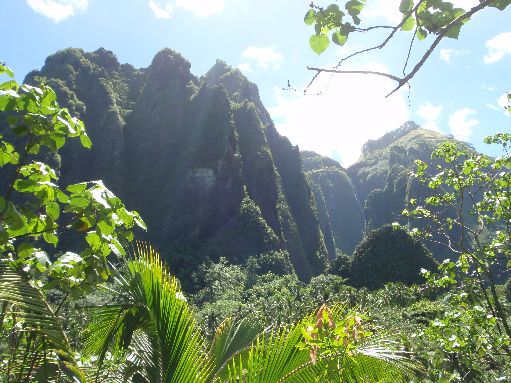
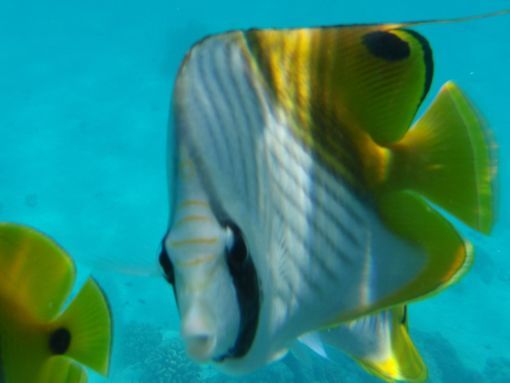
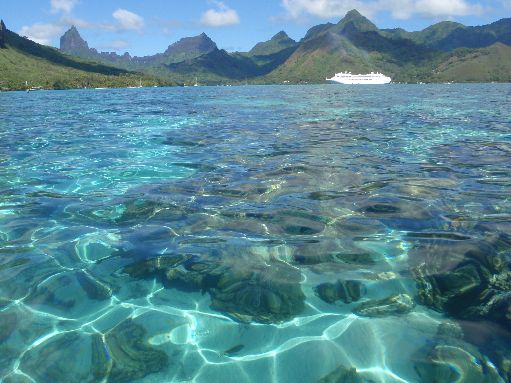
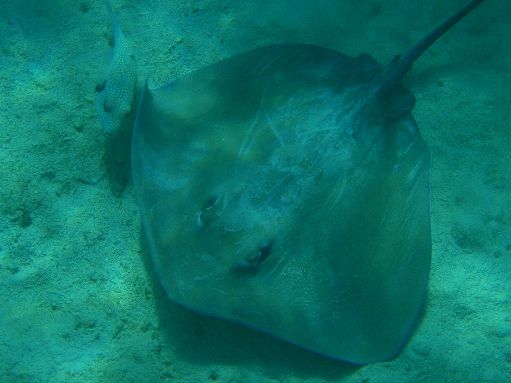
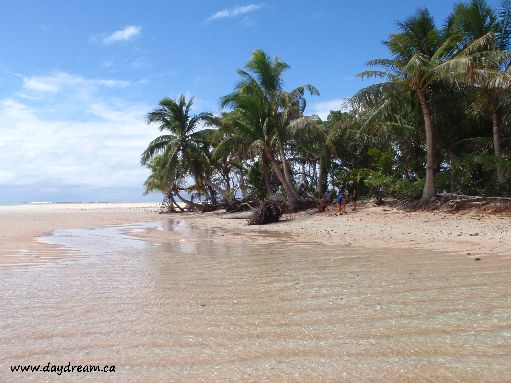
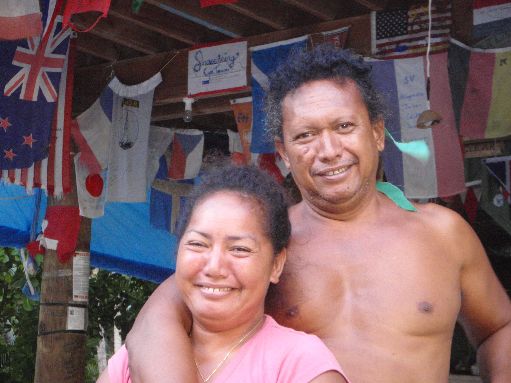
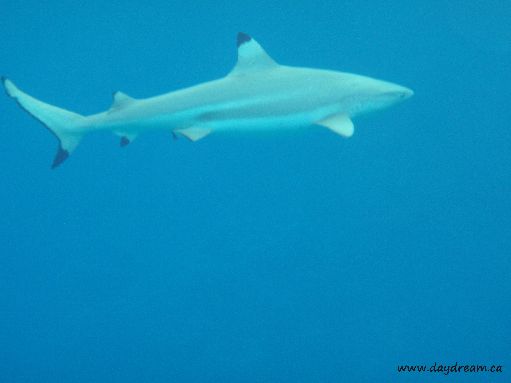
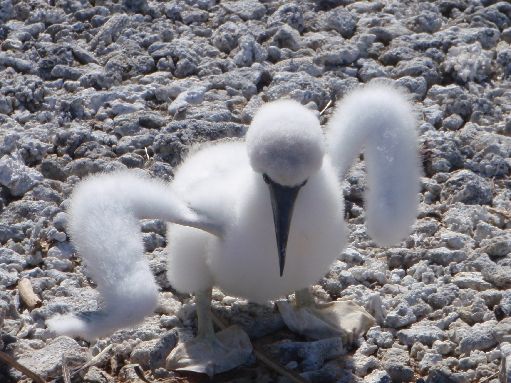
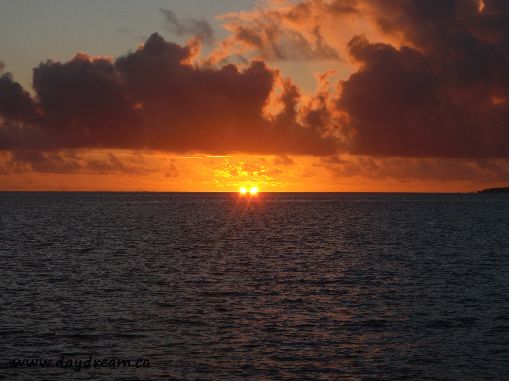
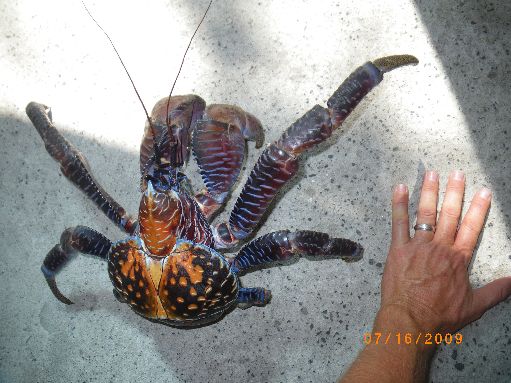
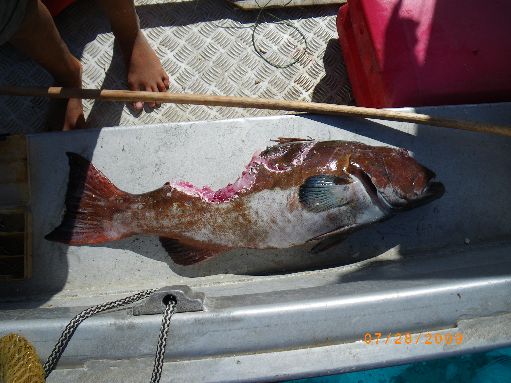
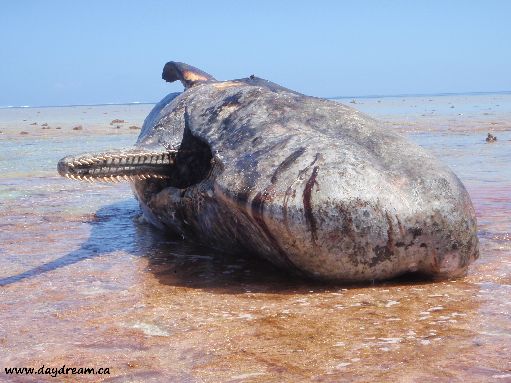
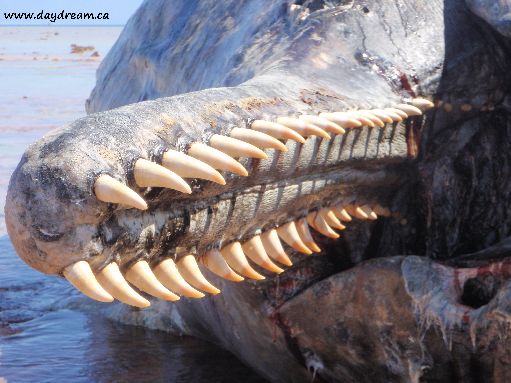
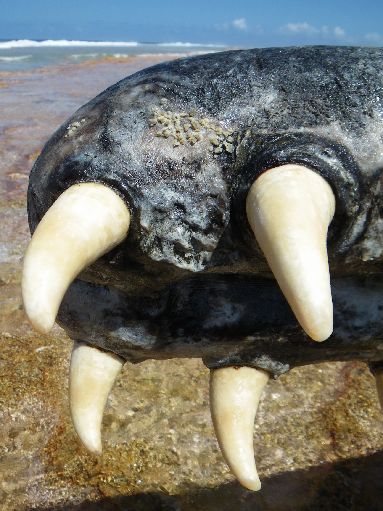
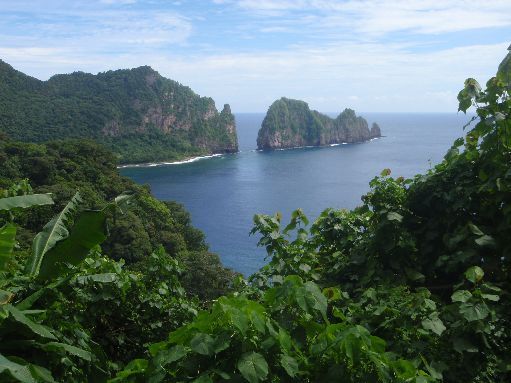
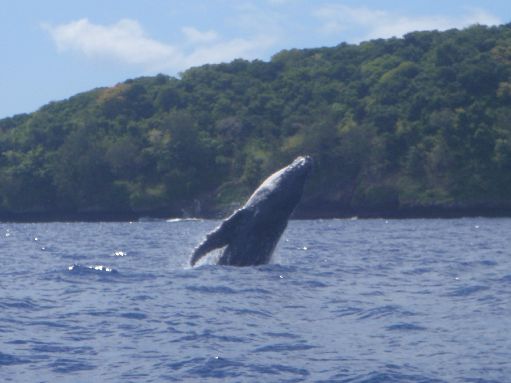
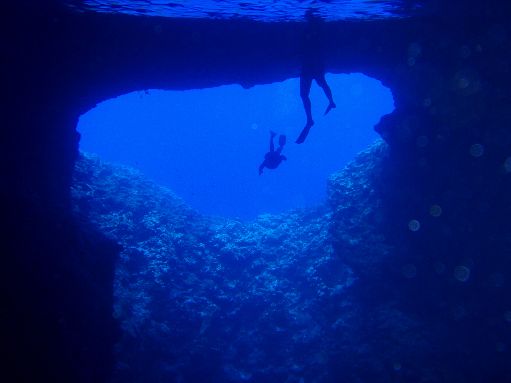
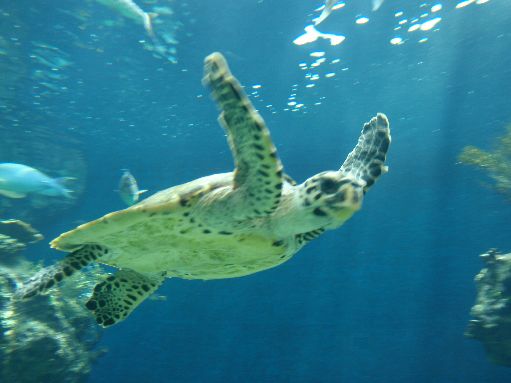
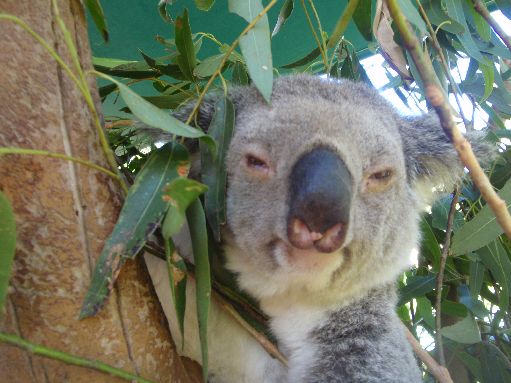
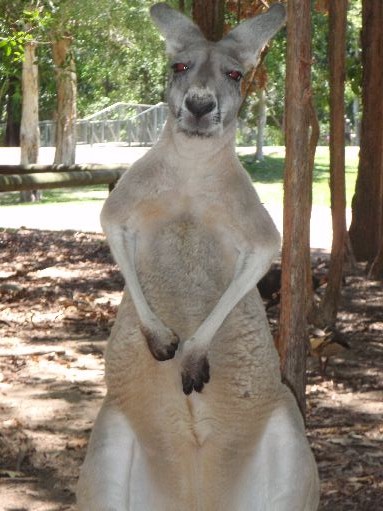

 If we were to describe the last ten months in a couple of words, they would have to be “carefree” and “relaxed”. In fact, from the time we purchased the new “Daydream” in late 2004 right up until February of 2006 we seem to have been under constant time pressures to be somewhere else and to be there quickly. Since March, we’ve finally felt that we truly had “nothing but time” as one of our favourite sayings goes. We’ve only covered about 1700 nautical miles since returning to the boat in February and all of those miles have been in the Sea of Cortez. Our only time pressure was to be well north in the Sea during hurricane season in the summer and fall.
If we were to describe the last ten months in a couple of words, they would have to be “carefree” and “relaxed”. In fact, from the time we purchased the new “Daydream” in late 2004 right up until February of 2006 we seem to have been under constant time pressures to be somewhere else and to be there quickly. Since March, we’ve finally felt that we truly had “nothing but time” as one of our favourite sayings goes. We’ve only covered about 1700 nautical miles since returning to the boat in February and all of those miles have been in the Sea of Cortez. Our only time pressure was to be well north in the Sea during hurricane season in the summer and fall. icans, low-diving grebes, a large, hairy tarantula and most exciting of all, whale sharks! Of course, it wasn’t all whales and sunsets. There was the usual amount of equipment breakage, routine maintenance and snotty weather to contend with which is all part of life on a boat.
icans, low-diving grebes, a large, hairy tarantula and most exciting of all, whale sharks! Of course, it wasn’t all whales and sunsets. There was the usual amount of equipment breakage, routine maintenance and snotty weather to contend with which is all part of life on a boat.
 We even made it as far north as Puerto Penasco way up on the mainland coast again. The tides in Penasco are still just as impressive at over 20 feet. That’s a lot of water to move in and out of that very small harbour every 6 hours! Which may have contributed to our inadvertently (as our friend Shelley would say) taking a piece of the dock with us when we left. There will be no more disussion on that particular subject so as not to make ourselves look silly. The new fuel dock in the harbour has to have a really, really long hose to accommodate the rise and fall of the boat being fuelled which makes for a couple of interesting photos at high and low tide.
We even made it as far north as Puerto Penasco way up on the mainland coast again. The tides in Penasco are still just as impressive at over 20 feet. That’s a lot of water to move in and out of that very small harbour every 6 hours! Which may have contributed to our inadvertently (as our friend Shelley would say) taking a piece of the dock with us when we left. There will be no more disussion on that particular subject so as not to make ourselves look silly. The new fuel dock in the harbour has to have a really, really long hose to accommodate the rise and fall of the boat being fuelled which makes for a couple of interesting photos at high and low tide. Henriette was getting close, we found a tiny little cove, which we named Twiggy Cove and backed the boat into it. We put two anchors out in front and six lines to shore. It was such a comfortable arrangement that we spent several weeks enjoying our private little spot. This bay is one of the nicest in the Sea with clear water and abundant sea life.
Henriette was getting close, we found a tiny little cove, which we named Twiggy Cove and backed the boat into it. We put two anchors out in front and six lines to shore. It was such a comfortable arrangement that we spent several weeks enjoying our private little spot. This bay is one of the nicest in the Sea with clear water and abundant sea life. flat sand beach that dries out at low tide. After removing the rudders which hang down below the bottom of the boat they anchored in a few inches of water then waited for the 15 foot tide to recede. After a few hours “Ebeneezer” was high and dry and perfectly flat. Over the next couple of tide cycles the painting was completed
flat sand beach that dries out at low tide. After removing the rudders which hang down below the bottom of the boat they anchored in a few inches of water then waited for the 15 foot tide to recede. After a few hours “Ebeneezer” was high and dry and perfectly flat. Over the next couple of tide cycles the painting was completed This last year featured visits from my sister Barb and also from our nephew, Algernon. Both of them visited while we were in the lovely city of La Paz. It was fun to see La Paz through Barb’s eyes as someone who had never been there before.
This last year featured visits from my sister Barb and also from our nephew, Algernon. Both of them visited while we were in the lovely city of La Paz. It was fun to see La Paz through Barb’s eyes as someone who had never been there before.  It really is a wonderful place. We also enjoyed a close encounter of the sea lion type in the dinghy with Barb along. As for Algernon, he got the four star arrival treatment when the dinghy was approached by a couple of large, interested dolphins as Wayne was bringing him out to the boat for the first time.
It really is a wonderful place. We also enjoyed a close encounter of the sea lion type in the dinghy with Barb along. As for Algernon, he got the four star arrival treatment when the dinghy was approached by a couple of large, interested dolphins as Wayne was bringing him out to the boat for the first time.
 us wouldn’t have happened in the islands that we had just left behind. Bonaire is a lovely island with some of the clearest water and most abundant tropical fish that we’ve ever seen. You aren’t allowed to anchor in Bonaire so we pulled up right in front of the main town of Kralendijk and picked up a buoy. We spent only a few days there. Just time to see a doctor about my cough and to do a little restaurant eating! Bonaire is part of the Netherlands Antilles just like Sint Maarten but it is much more “Dutch”. We suffered a bit of sticker shock, as it had been a while since we’d spent any money at all and the prices were a lot higher than in Venezuela.
us wouldn’t have happened in the islands that we had just left behind. Bonaire is a lovely island with some of the clearest water and most abundant tropical fish that we’ve ever seen. You aren’t allowed to anchor in Bonaire so we pulled up right in front of the main town of Kralendijk and picked up a buoy. We spent only a few days there. Just time to see a doctor about my cough and to do a little restaurant eating! Bonaire is part of the Netherlands Antilles just like Sint Maarten but it is much more “Dutch”. We suffered a bit of sticker shock, as it had been a while since we’d spent any money at all and the prices were a lot higher than in Venezuela.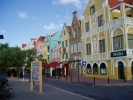 Waters. It’s a good thing it was well protected as we experienced 20-25 knots of wind and rain squalls almost every day. A twenty-minute bus ride would get us to the main city and harbour of Willemstad. The architecture and colour of the buildings is just amazing. In between stocking up and working on the boat we squeezed in a little time for socializing and catching a few movies at the theatre in town.
Waters. It’s a good thing it was well protected as we experienced 20-25 knots of wind and rain squalls almost every day. A twenty-minute bus ride would get us to the main city and harbour of Willemstad. The architecture and colour of the buildings is just amazing. In between stocking up and working on the boat we squeezed in a little time for socializing and catching a few movies at the theatre in town. because it stands a couple hundred feet high as compared to most of the islands, which are exactly the height of the tallest palm tree, plus about 3 feet of sand. Isla Pinos is near the eastern end of Panama, very close to the Columbian border and is in the least developed area of the Kuna Yala. The people here live in houses that you can see through. The walls are made of upright sticks and the roofs are thatch. There is very little electricity although some villages had a TV with DVD and a generator or solar panels to run it. There are no cars and very few outboard motors.
because it stands a couple hundred feet high as compared to most of the islands, which are exactly the height of the tallest palm tree, plus about 3 feet of sand. Isla Pinos is near the eastern end of Panama, very close to the Columbian border and is in the least developed area of the Kuna Yala. The people here live in houses that you can see through. The walls are made of upright sticks and the roofs are thatch. There is very little electricity although some villages had a TV with DVD and a generator or solar panels to run it. There are no cars and very few outboard motors. hollowed out (by hand) log canoe to get to and from the ‘office’. If they are farmers, they farm mostly coconuts but also some mangoes, bananas, platanos and a few veggies. The coconuts are the main crop and the main source of export earnings. Every town has a little concrete dock that the coconut traders dock at to buy coconuts. They show up in extremely colourful and dilapidated old wooden shrimp boats and buy coconuts for 10 cents each and sell flour, sugar and luxuries like potato chips to the locals. Because most of these boats are operated by Columbians and these are the only outsiders that many of these folks normally see, they often asked us if we were Columbians.
hollowed out (by hand) log canoe to get to and from the ‘office’. If they are farmers, they farm mostly coconuts but also some mangoes, bananas, platanos and a few veggies. The coconuts are the main crop and the main source of export earnings. Every town has a little concrete dock that the coconut traders dock at to buy coconuts. They show up in extremely colourful and dilapidated old wooden shrimp boats and buy coconuts for 10 cents each and sell flour, sugar and luxuries like potato chips to the locals. Because most of these boats are operated by Columbians and these are the only outsiders that many of these folks normally see, they often asked us if we were Columbians. One of our favourite sights in the Kuna Yala was the pigsties. For some reason that we never quite figured out, they build little one-pig sties about 3 feet off the ground, right on the ocean front. Anywhere else in the world this would be million dollar real estate!
One of our favourite sights in the Kuna Yala was the pigsties. For some reason that we never quite figured out, they build little one-pig sties about 3 feet off the ground, right on the ocean front. Anywhere else in the world this would be million dollar real estate! through the top layers to display the colours of the layers beneath. The good ones are painstaking works that can take months to make and it is almost impossible to see the tiny stitches. Two matching panels are sewn for each blouse and then connected together by a neckline and sleeves. Molas are often characterized by rather unique colour combinations due to the Kuna’s love of red, burgundy and orange!
through the top layers to display the colours of the layers beneath. The good ones are painstaking works that can take months to make and it is almost impossible to see the tiny stitches. Two matching panels are sewn for each blouse and then connected together by a neckline and sleeves. Molas are often characterized by rather unique colour combinations due to the Kuna’s love of red, burgundy and orange! were very friendly and the culture very interesting. The area was highly photogenic. Between the colourful people themselves, their fascinating villages, the uninhabited coral island paradises and the underwater gardens of diverse coral; it was truly a slice of heaven. We could go on for hours discussing the San Blas but it’s time to move on. Please take a moment to see some of the incredible photos from this area on our website.
were very friendly and the culture very interesting. The area was highly photogenic. Between the colourful people themselves, their fascinating villages, the uninhabited coral island paradises and the underwater gardens of diverse coral; it was truly a slice of heaven. We could go on for hours discussing the San Blas but it’s time to move on. Please take a moment to see some of the incredible photos from this area on our website. We had one quick stop in the historic port of Portobelo before reaching the Panama Canal from the San Blas Islands. Portobelo was one of the ports along the route of the Spanish treasure fleets. We only had a day to spend here but Wayne took some great photos of the old Spanish forts surrounding the bay.
We had one quick stop in the historic port of Portobelo before reaching the Panama Canal from the San Blas Islands. Portobelo was one of the ports along the route of the Spanish treasure fleets. We only had a day to spend here but Wayne took some great photos of the old Spanish forts surrounding the bay. one of our favourite cities and it is even prettier as they have made wonderful improvements on the waterfront malecon. We enjoyed the many anchorages north of La Paz as we worked our way up to Bahia Concepcion along the way drinking in the spectacular desert/ocean landscapes. Here we stopped for our final bit of cruising this season before heading across the Sea of Cortez to San Carlos. The weather was really heating up and Concepcion lived up to its reputation as ‘the oven’.
one of our favourite cities and it is even prettier as they have made wonderful improvements on the waterfront malecon. We enjoyed the many anchorages north of La Paz as we worked our way up to Bahia Concepcion along the way drinking in the spectacular desert/ocean landscapes. Here we stopped for our final bit of cruising this season before heading across the Sea of Cortez to San Carlos. The weather was really heating up and Concepcion lived up to its reputation as ‘the oven’.

